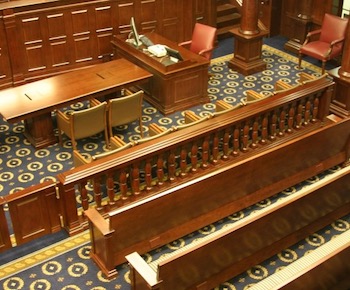 Polaris Indus. v. Arctic Cat, Inc., Nos. 2016-1807, 2016-2280, (Fed. Cir. Feb. 9, 2018) (Before Lourie, O’Malley, and Hughes, J.) (Opinion for the court, O’Malley, J.).
Polaris Indus. v. Arctic Cat, Inc., Nos. 2016-1807, 2016-2280, (Fed. Cir. Feb. 9, 2018) (Before Lourie, O’Malley, and Hughes, J.) (Opinion for the court, O’Malley, J.).
Polaris owns U.S. Patent No. 8,596,405, which directed to all terrain vehicles (ATVs) having at least two seats arranged side-by-side. Arctic Cat filed two inter partes review (IPR) petitions challenging the Polaris’ patent, based on two different combinations of references. The Board found that the claims were unpatentable as obvious in the first IPR and were not proven unpatentable in the second IPR. The parties cross-appealed to the Federal Circuit.
On appeal the Federal Circuit affirmed-in-part, vacated-in-part, and remanded the Board’s unpatentability decision in the first IPR and affirmed the Board’s decision in the second IPR that the claims remained patentable.
According to the Federal Circuit, the Board relied on impermissible hindsight. Polaris presented undisputed evidence that placing the fuel tank of an ATV underneath the seats would significantly raise the occupancy area, which is contrary to prior art teachings. This was used to support Polaris’ arguments that the prior art taught away from the claimed combinations. The Federal Circuit concluded that the Board failed to consider this undisputed evidence. Namely, the Board criticized Polaris’s arguments as not focusing on whether a modification was known to implement and had known benefits, to rely instead relying on teachings that were simply “subjective preferences.”
“[I]t is undisputed that adding a fuel tank under one of the seats of Denney’s ATV would significantly raise its occupancy area, thereby raising the center of gravity and rendering the vehicle less stable, which would run contrary to one of Denney’s stated purposes.” Judge O’Malley wrote. “The Board’s treatment of this evidence was deficient, and we therefore vacate its determination that claim 17 would have been obvious. Because claims 18 and 19 depend from claim 17, we vacate the Board’s obviousness determination with respect to those claims as well.”
The Federal Circuit specifically found three problems with the Board analysis: 1) by disregarding Polaris’ evidence that the prior art teaches away from combination, the Board engaged in impermissible hindsight, 2) the Board considered instead what a person of ordinary skill would have been able to do not what they would have been motivated to do, and 3) the Board’s analysis encourages the fact-finder to disregard relevant evidence.
The Federal Circuit also remanded to the Board further consideration of the undisputed evidence presented by Polaris that its ATVs were a commercial success. Polaris presented undisputed evidence that its vehicles had generated over $1.5 billion in sales since 2007 and that the commercial product was tied to the patent and claims entitling Polaris to a presumption of a nexus. Despite this undisputed evidence the Board still concluded that Polaris failed to prove a nexus, finding Polaris’ evidence conclusory.
In PPC Broadband, Inc. v. Corning Optical Communications RF, LLC, 815 F.3d 734 (Fed. Cir. 2016), the Court found that “[w]hen the patentee has presented undisputed evidence that its product is the invention disclosed in the challenged claims, it is error for the Board to find to the contrary without further explanation.” Here, the Federal Circuit not only disagreed with the Board’s conclusion, but found that Polaris had presented enough evidence to support a presumption of a nexus between that commercial success and the claims of the ‘405 patent.
Take Away
To avoid hindsight, an obvious to combine analysis should focus on what a person of ordinary skill would have been motivated to do, not merely on what they would have been able to do. Further, where a party presents undisputed evidence of commercial success, the Board must articulate some reason why the evidence does not deserve a presumption of a nexus between the commercial success and the claimed invention.
[Troutman-Ad]
[Troutman-About]

![[IPWatchdog Logo]](https://ipwatchdog.com/wp-content/themes/IPWatchdog%20-%202023/assets/images/temp/logo-small@2x.png)



![[Advertisement]](https://ipwatchdog.com/wp-content/uploads/2024/05/Quartz-IP-May-9-2024-sidebar-700x500-1.jpg)
![[Advertisement]](https://ipwatchdog.com/wp-content/uploads/2024/04/Patent-Litigation-Masters-2024-sidebar-last-chance-700x500-1.jpg)

![[Advertisement]](https://ipwatchdog.com/wp-content/uploads/2021/12/WEBINAR-336-x-280-px.png)
![[Advertisement]](https://ipwatchdog.com/wp-content/uploads/2021/12/2021-Patent-Practice-on-Demand-recorded-Feb-2021-336-x-280.jpg)
![[Advertisement]](https://ipwatchdog.com/wp-content/uploads/2021/12/Ad-4-The-Invent-Patent-System™.png)






Join the Discussion
No comments yet.